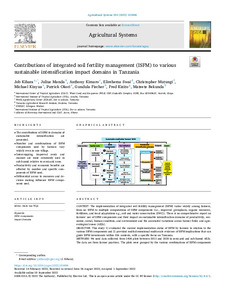| dc.contributor.author | Kihara, J. |
| dc.contributor.author | Manda, J. |
| dc.contributor.author | Kimaro, A. A. |
| dc.contributor.author | Swai, E. |
| dc.contributor.author | Mutungi, C. |
| dc.contributor.author | Kinyua, M. |
| dc.contributor.author | Okori, P. |
| dc.contributor.author | Fischer, G. |
| dc.contributor.author | Kizito, F. |
| dc.contributor.author | Bekunda, M. |
| dc.date.accessioned | 2022-10-31T09:12:56Z |
| dc.date.available | 2022-10-31T09:12:56Z |
| dc.date.issued | 2022-12 |
| dc.identifier.citation | Kihara, J., Manda, J., Kimaro, A.A., Swai, E., Mutungi, C., Kinyua, M., ... & Bekunda, M. (2022). Contributions of integrated soil fertility management (ISFM) to various sustainable intensification impact domains in Tanzania. Agricultural Systems, 203: 103496, 1-16. |
| dc.identifier.issn | 0308-521X |
| dc.identifier.uri | https://hdl.handle.net/20.500.12478/7920 |
| dc.description.abstract | CONTEXT The implementation of integrated soil fertility management (ISFM) varies widely among farmers, from no ISFM to multiple computations of ISFM components (i.e., improved germplasm, organic resources, fertilizers, and local adaptations e.g., soil and water conservation (SWC)). There is no comprehensive report on farmers' use of ISFM components and their impact on sustainable intensification domains of productivity, economic, social, human condition, and environment and the associated variations across farmer fields and agro-ecological zones (AEZs). OBJECTIVE This study 1) evaluated the current implementation status of ISFM by farmers in relation to the various ISFM components and 2) provided multi-dimensional multi-scale evidence of ISFM implications that can guide ISFM investments within SSA contexts, with a specific focus on Tanzania. METHODS We used data collected from 1406 plots between 2013 and 2020 in semi-arid and sub-humid AEZs. The data are from farmer practices. The plots were grouped by the various combinations of ISFM components implemented and analysed using Tukey's test to examine the association of ISFM use with selected indicators within a domain. RESULTS AND CONCLUSIONS The number of ISFM components used by farmers is higher in sub-humid (1 to 4) than in semi-arid AEZ (0 to 3). Except for SWC used by 40% of farmers in both AEZs, the proportion of farmers using improved seeds (95%) and manure (55%) in the sub-humid AEZ are more than double those using these ISFM components in the semi-arid AEZ. Productivity and economic benefits increase with the number of ISFM components at the expense of higher labour demand. Increasing plot-level ISFM benefits also translate to increased household-level whole-farm income but contributions to human nutrition are unclear. The contribution to SOC by increasing ISFM is insignificant, compounded by strong effects of slope position of the field. Differential access to resources, decision-making and control rights drive the number and choice of the specific ISFM components. SIGNIFICANCE Understanding of ISFM impacts across domains is essential to guide the scaling of ISFM in Tanzania and beyond and therefore recommended in future studies. |
| dc.format.extent | 1-16 |
| dc.language.iso | en |
| dc.subject | Soil Fertility |
| dc.subject | Sustainable Intensification |
| dc.subject | Crop Production |
| dc.subject | Tanzania |
| dc.title | Contributions of integrated soil fertility management (ISFM) to various sustainable intensification impact domains in Tanzania |
| dc.type | Journal Article |
| cg.contributor.crp | Grain Legumes |
| cg.contributor.crp | Maize |
| cg.contributor.crp | Policies, Institutions and Markets |
| cg.contributor.affiliation | International Center of Tropical Agriculture |
| cg.contributor.affiliation | International Institute of Tropical Agriculture |
| cg.contributor.affiliation | World Agroforestry Center |
| cg.contributor.affiliation | Tanzania Agricultural Research Institute |
| cg.contributor.affiliation | International Crops Research Institute for the Semi-Arid Tropics |
| cg.contributor.affiliation | Alliance of Bioversity International and CIAT |
| cg.coverage.region | Africa |
| cg.coverage.region | East Africa |
| cg.coverage.country | Tanzania |
| cg.coverage.hub | Eastern Africa Hub |
| cg.coverage.hub | Headquarters and Western Africa Hub |
| cg.researchtheme | Natural Resource Management |
| cg.researchtheme | Plant Production and Health |
| cg.researchtheme | Social Science and Agribusiness |
| cg.identifier.bibtexciteid | KIHARA:2022 |
| cg.isijournal | ISI Journal |
| cg.authorship.types | CGIAR and developing country institute |
| cg.iitasubject | Agronomy |
| cg.iitasubject | Food Security |
| cg.iitasubject | Plant Breeding |
| cg.iitasubject | Plant Production |
| cg.iitasubject | Soil Fertility |
| cg.journal | Agricultural Systems |
| cg.notes | Published online: 18 Sep 2022 |
| cg.accessibilitystatus | Open Access |
| cg.reviewstatus | Peer Review |
| cg.usagerightslicense | Creative Commons Attribution 4.0 (CC BY 0.0) |
| cg.targetaudience | Scientists |
| cg.identifier.doi | https://dx.doi.org/10.1016/j.agsy.2022.103496 |
| cg.iitaauthor.identifier | Julius Manda: 0000-0002-9599-5906 |
| cg.iitaauthor.identifier | Gundula Fischer: 0000-0002-7658-786X |
| cg.iitaauthor.identifier | Mateete Bekunda: 0000-0001-7297-9383 |
| cg.futureupdate.required | No |
| cg.identifier.volume | 203 |

